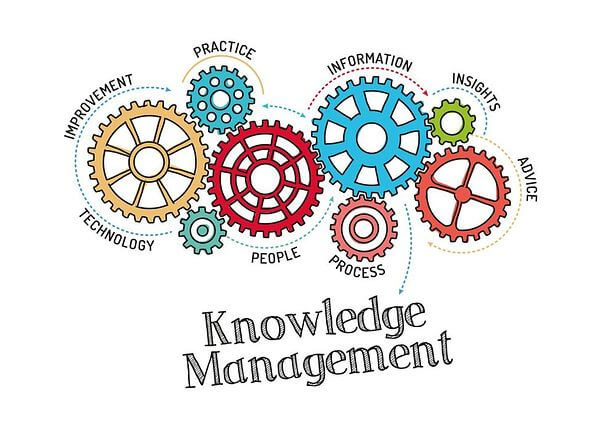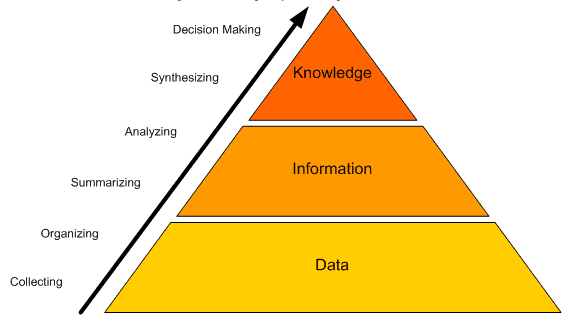
Do you know that companies that apply knowledge management, on average, increase their efficiency in productivity as well as strengthen their innovative capabilities by a higher-than-average rate?
Wouldn't it be great if you could help push your company ahead of the competition by making a few operational changes?
Is it crazy to think that there's an easy six-step process that can help you with the changes needed to be ahead of the competition?
Well, that's what knowledge management is all about. In this article, we'll show you exactly how it can help, but before we do, let's briefly touch on what knowledge is related to a business.
Understanding Knowledge in Business
Knowledge in organizations can be categorized into four main types: explicit knowledge, tacit knowledge, implicit knowledge, and tribal knowledge.
1. Explicit Knowledge
Explicit knowledge is the type of knowledge that can easily be documented in written form, stored in a database, and share as well as transferred to others. Examples of this type of knowledge include:
- Product FAQs
- Software documentation
- Process documentation
- User documentation
2. Tacit Knowledge
Tacit knowledge on the other hand is the type of knowledge that is difficult (but not impossible) to document. This is because tacit knowledge is based on personal experiences and is context-specific. This type of knowledge is not easy to articulate which therefore makes it difficult to codify. Examples of this type of knowledge include:
- Hunches
- Intuitions
- Leadership skills
- Body language interpretation
- Emotional intelligence
3. Implicit Knowledge
Implicit knowledge is information that is not easily expressed but can still be inferred, usually through observation or analysis. Examples of this type of knowledge include
- Best practices
- Workflow patterns
- Organizational culture.
4. Tribal Knowledge
Tribal knowledge is the collective wisdom, experience, and expertise of a group, often passed down informally through storytelling, mentoring, or on-the-job training. This type of knowledge is deeply rooted in the organization's culture, making it difficult to transfer outside the group.
The more tacit, implicit, and tribal knowledge that you can transform into explicit knowledge, the more knowledge capital your business has the ability to leverage.
The Six-Step Knowledge Management Process
Embracing a knowledge management process is vital and cannot be overstated. Imagine a world where employees and management can access relevant information quickly, making well-informed decisions with ease. This is the power of an effective knowledge management process.
But the benefits don't stop there. Encouraging the sharing of knowledge across departments and teams fosters a collaborative environment ripe for innovation. Your teams will work together, exchanging ideas and finding groundbreaking solutions to complex problems.
Imagine the hours saved when employees can readily access the information they need. The streamlined knowledge management process not only saves time but also boosts overall efficiency.
And what about preserving your company's hard-earned knowledge? When employees leave or change roles, the knowledge management process ensures that their invaluable insights are retained and available for future use.
Lastly, this process promotes a culture of continuous learning, empowering your organization to adapt to ever-changing market conditions and consistently stay ahead of the competition.

While there isn't a one-size-fits-all model for knowledge management, a typical six-step process may include the following stages:
1. Collecting
Initiate the process by proactively seeking out relevant data for your organization. Focus on information that holds the highest value for your knowledge management efforts. Engage your employees in knowledge sharing sessions, interviews, and workshops to capture their tacit knowledge. Empower a dedicated team to gather, document, and curate this data while fostering a collaborative culture of open communication.
2. Organizing
Systematically organize the collected data using a well-structured taxonomy or tagging system based on your company's objectives. Leverage technology like artificial intelligence (AI) and machine learning (ML) tools to automate categorization, making the information more accessible and actionable for your team members.
3. Summarizing
Transform the information into easily digestible content by summarizing its key points. Use visually appealing charts, infographics, or interactive dashboards to present the information in an engaging and meaningful manner. This will enable stakeholders to grasp the essence of the knowledge quickly and efficiently.
4. Analyzing
Delve deep into the summarized information to uncover hidden patterns, relationships, and potential implications. Use advanced analytical tools to evaluate the data from multiple perspectives and generate comprehensive reports. Involve subject matter experts to provide insights and context, further enriching the understanding of the findings.
5. Synthesizing
Turn the analyzed information into actionable knowledge by integrating the insights derived from the reports. Identify opportunities to create a competitive advantage, strengthen productivity, and foster innovation within the company. Encourage cross-departmental collaboration by breaking down silos and sharing knowledge across teams.
Leverage cutting-edge knowledge base software to create a centralized and easily accessible repository. Implement features such as search functionality, version control, and user access management to facilitate seamless collaboration and knowledge sharing.
6. Decision Making
Harness the power of your actionable knowledge to make data-driven decisions and optimize the allocation of resources. Continuously assess the applicability and relevance of the knowledge to various tasks, projects, and departments within your organization.
Adopt an agile approach when implementing the knowledge, allowing for iterative improvements based on feedback and changing circumstances. This will enable your organization to adapt swiftly to evolving market conditions and maintain a competitive edge in today's dynamic business landscape.
By incorporating these steps into your knowledge management process, you'll create an engaging and actionable system that fosters continuous learning, innovation, and growth for your organization.
Best Practices to Get Employees Excited About Knowledge Management
Though knowledge management sounds wonderful in theory, we are still missing the realistic aspect of how we can, in different ways, distribute it.
Your goal is to engage everybody in the positivity of KM in order to see how you can share it in the best way. There are several best practices for knowledge management that can help employees get the most from your KM initiatives, starting with creating a group e-mail list, whose purpose would be to share particular knowledge for anybody interested in that type of information.
This will activate the interest of those specific people who need quick access to that knowledge and they will always be kept up to date.
Another way, and arguably a more interesting way, would be to create communities of practice where employees can openly share knowledge. Or you can task one or more employees to be knowledge leaders to help with organizing and managing all of an organization's internal knowledge in a blog or internal wiki.
With an added and smooth search function, you can better enable employees to find the knowledge they need. This, of course, requires a bit of investment in the documents or articles written where you would put various tags and keywords related to what the person might be searching for in the future.
To further add on to the points above, most organizations will follow the 80/20 rule, which states that about 80% of people will search for 20% of the knowledge. That 20% is therefore important to define and put as a priority. These are key questions that absolutely need an answer in an easy-to-find way.
As you may have figured out, the best way of doing this is to create a FAQ Section for people to navigate through. This basically speaks for itself and it’s up to you to choose and cherry-pick your important questions that need answers.
What you decide to do and how you take it from here is entirely up to your standards of what is important and how you need it to be available. There are numerous other ways in which you can further spread the knowledge, but that goes beyond this article and is easily accessible on the web.
There are, however, a few more points said below if you don’t already feel motivated enough.
Benefits of Knowledge Management
This has already spoken for itself up until this point, but it never hurts to layout the resulting pros for the usage of KM:
- It serves customers well now that you are quicker in your decision making and know exactly where to implement your knowledge.
- It reduces cycle times. Everybody has more concrete access to useful knowledge and know exactly where to use it.
- Product development time greatly reduces. All the fuzzy and irrelevant knowledge is no longer a problem and you can focus solely on the areas that matter.
- Customer service improves. You now have more direct access to answers to questions.
- Improves the quality of communication between you and your employees. With everything outlined and ready to go, you and your employees are basically speaking the same language to each other when communicating and everybody knows exactly what to do at all times.
- It leaves more time to further innovate and develop a higher quality product now that all the other work is being dealt with much faster. Most importantly, you save a lot of money now that costs are dramatically reduced for everything above.
Frankly, is there a reason not to use knowledge management to your advantage? I can’t think of a single reason.
It will only do good for you, your company, your employees – and your customers. It’s all a matter of organizing yourself better and leaving less room for confusion and shallow work that will be nothing but time-consuming.
Think about all the possibilities you are left with when you have information that you know exactly what to do with and tasks that you hand out that your employees will know exactly how to deal with.
Knowledge management is best described as ‘productivity-heaven’ and should definitely be capitalized on for anyone who wants to do better!
We’d love to hear YOUR thoughts on how you’ve incorporated knowledge management into your company! Please tag us on social media with any tips or hacks you’ve been using successfully.

